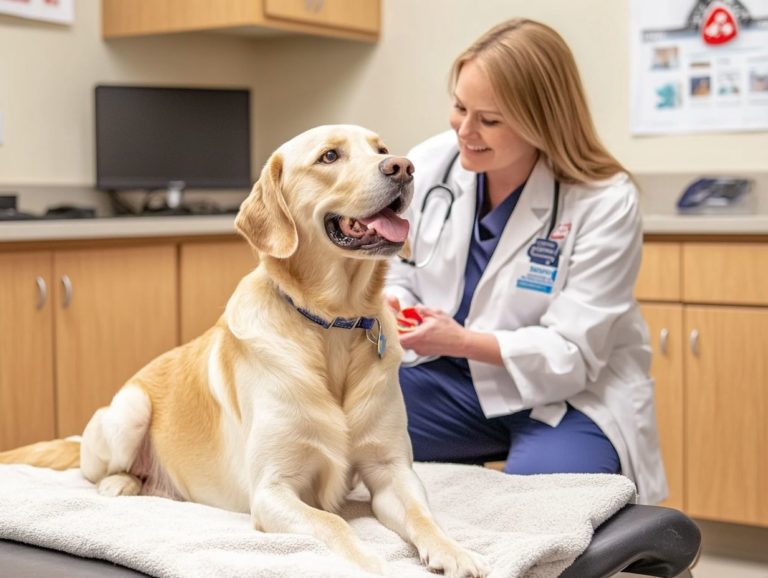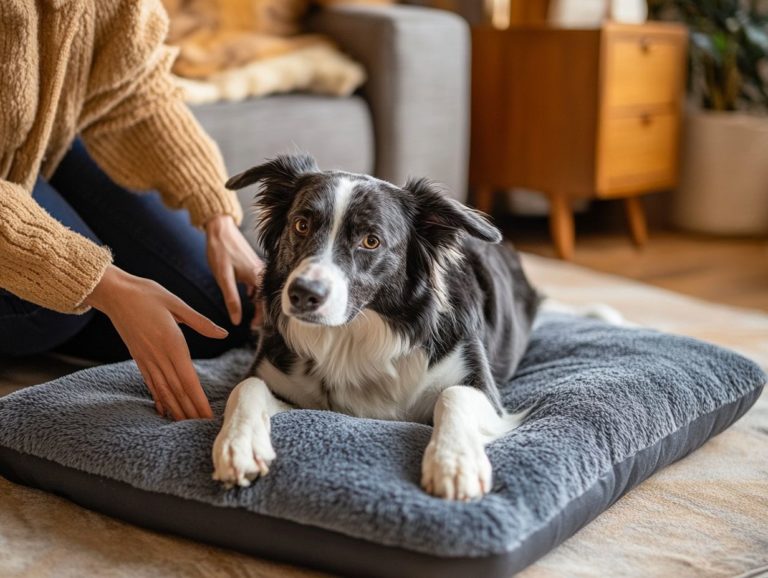The Influence of Environment on Pet Anxiety
Pet anxiety is a growing concern for many pet owners. It affects both furry companions and the humans who care for them.
Understanding the causes and symptoms is crucial. Factors like loud noises and changes in routine can significantly contribute to anxiety.
Creating a calming environment is essential. You can explore alternative solutions, such as medication and therapy.
Take steps to help your pet feel safe and secure.
Contents
- Key Takeaways:
- Understanding Pet Anxiety
- Impact of Environment on Pet Anxiety
- Factors that Contribute to Anxiety
- Signs of Environmental Stress
- Creating a Calming Environment for Pets
- Tips for Reducing Anxiety Triggers
- Alternative Solutions for Pet Anxiety
- Preventing and Managing Pet Anxiety
- Frequently Asked Questions
- What is the influence of environment on pet anxiety?
- How does noise level impact pet anxiety?
- Can socialization opportunities affect pet anxiety and influence canine behavioral issues?
- Is physical space important for managing pet anxiety?
- What are some environmental factors that can contribute to pet anxiety?
- How can I create a more anxiety-friendly environment for my pet?
Key Takeaways:
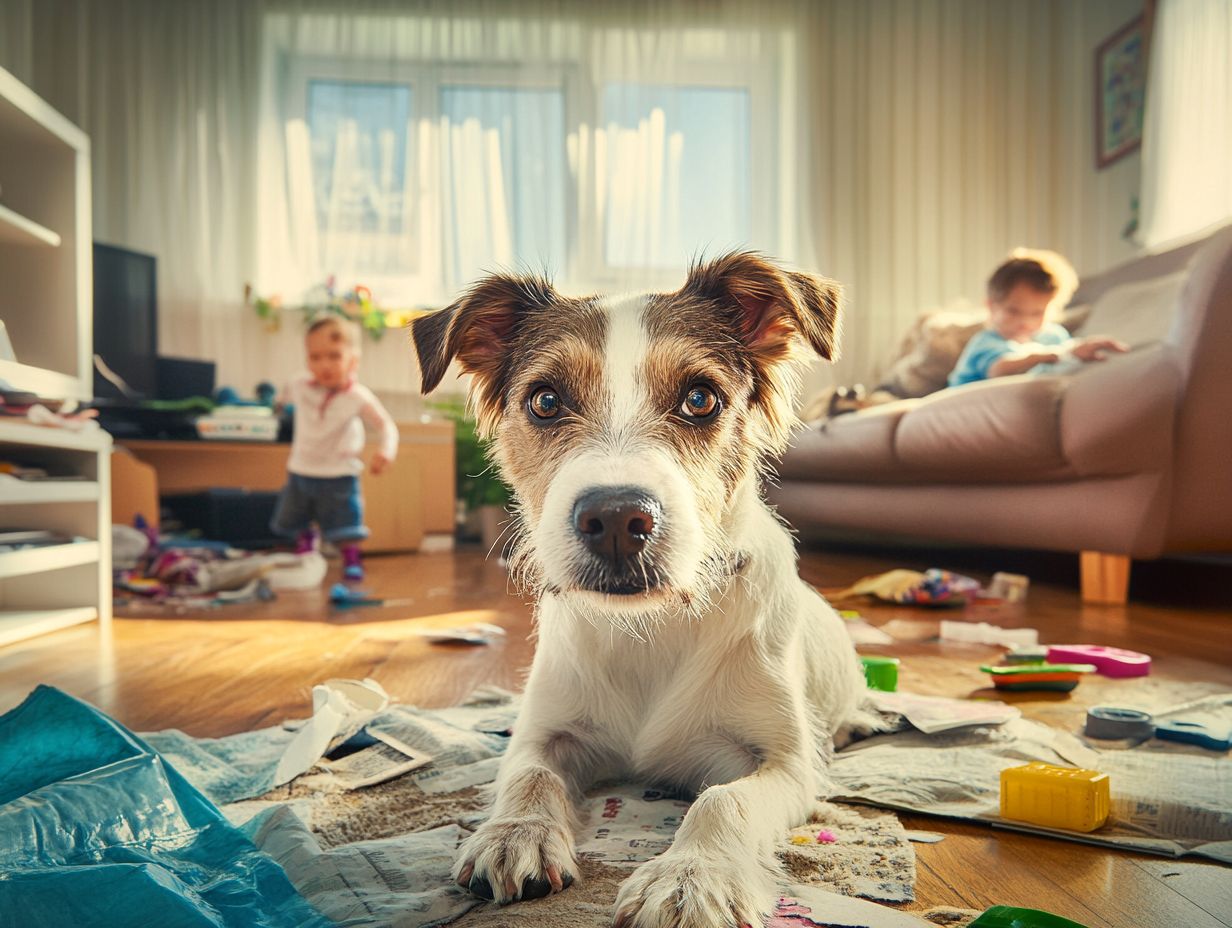
- Pet anxiety can stem from various factors, including their environment.
- Signs of stress in pets may include destructive behavior, excessive grooming, and changes in appetite.
- To create a calming space, minimize noise, provide a safe area, and include soothing scents.
Understanding Pet Anxiety
As a pet owner, understanding pet anxiety is vital. It impacts your dog’s well-being and daily activities.
Different breeds, like Golden Retrievers or Chihuahuas, show varying anxiety levels. Many dogs fear other animals or strangers, leading to serious behavioral issues.
Recognizing these problems early lets you take action, such as providing environmental enrichment and engaging in training activities.
By understanding your dog’s anxiety, you can create a supportive environment. This fosters emotional stability and benefits both of you.
Causes and Symptoms
Pet anxiety in dogs stems from a mix of genetics and environment. To better understand this issue, it’s important to consider key factors in understanding pet anxiety, as it often shows up as fearfulness or behavioral problems.
Family size and exercise frequency can also affect anxiety. Larger households may create more noise, overwhelming sensitive breeds.
If your dog lives in a city, they may experience more stress due to constant noise and activity, which can increase their anxiety levels. Understanding the role of diet in pet anxiety can be helpful in managing these stressors.
Common signs include aggression, cowering, and excessive barking. Understanding these signs is crucial for creating a peaceful home.
Impact of Environment on Pet Anxiety
Your pet’s environment greatly influences their anxiety, and understanding anxiety triggers in pets can help you identify specific factors. Urban living and early socialization play key roles.
Dogs in cities might struggle due to limited exposure to different experiences. This makes them more susceptible to fears.
On the other hand, enhancing their environment can boost their emotional health. Staying aware of how your surroundings impact your furry friends is crucial, and understanding the role of veterinary advice in managing pet anxiety can also provide valuable insights.
Factors that Contribute to Anxiety
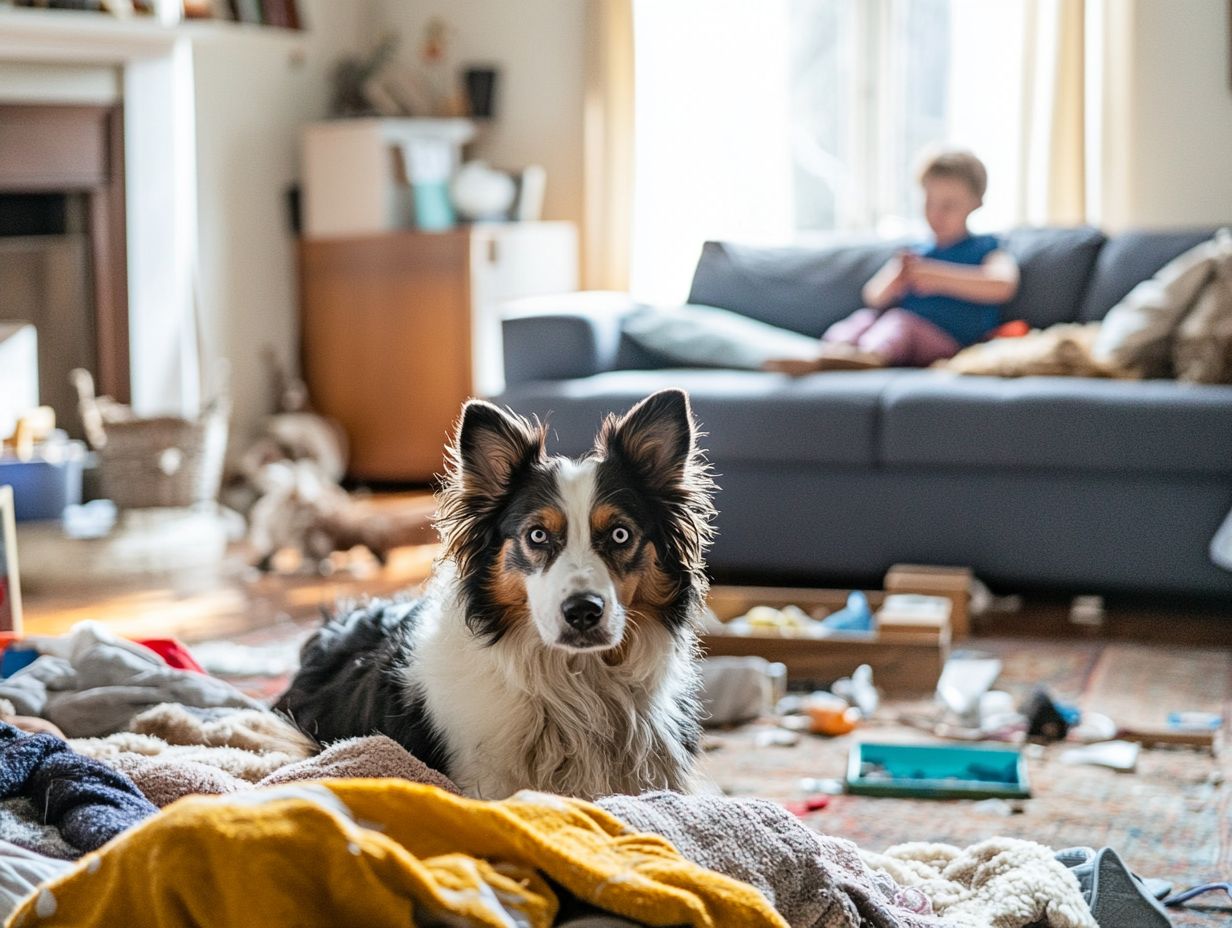
Several demographic factors, such as body size and family size, can affect anxiety in your pet dog. This includes how often they exercise and the nature of their training activities. These factors can vary based on your dog’s body size and whether or not they’ve been neutered.
For instance, a dog that enjoys regular walks and plenty of playtime is more likely to exhibit calm behavior and be less susceptible to fear-related issues, especially if they belong to breeds known for their behavioral traits. If your dog is part of a larger household, they might thrive on social interactions or feel overwhelmed, depending on their individual temperament.
Consistent training sessions are equally important, as they teach commands and establish a sense of structure and security. This is especially crucial for breeds like the Labrador Retriever and German Shepherd Dog, which may be more anxious. A well-trained dog usually feels more confident in their environment.
Make sure your dog gets plenty of exercise and provides socialization opportunities. This can significantly reduce behavioral problems and promote a more balanced state of mind for your furry friend.
Signs of Environmental Stress
Identifying the signs of environmental stress in dogs is essential for managing canine anxiety. This can affect both the animal’s behavior and overall public health. You may notice that fearful behaviors often manifest as aggression or avoidance of specific stimuli in their surroundings.
These behaviors can range from cowering in corners to excessive barking when encountering other animals. Both signal heightened stress and can indicate fear of dogs (known as conspecific fear) or fear of strangers. Recognizing these signs is crucial for you as a pet owner, as they can arise from various triggers, including loud noises, unexpected encounters with unfamiliar dogs, or even changes in your household routine.
By closely observing your pet’s reactions, such as tail tucking or lip licking, you can create effective strategies to alleviate these fears. This might include establishing a safe space for them or using gradual desensitization techniques, which can particularly help fearful dogs.
Creating a Calming Environment for Pets
Creating a calming environment for pets is vital for enhancing their overall well-being and alleviating anxiety, especially in dogs that are more prone to fearfulness. Implementing the top 10 environmental adjustments for anxious pets can make a significant difference.
Incorporating elements of environmental enrichment such as cozy resting areas, engaging toys, and a structured routine of training activities can significantly enhance your dog’s mental stimulation, health, and comfort.
This proactive approach not only reduces fearfulness but also nurtures a deeper bond between you and your pet, fostering an environment rich in emotional support that encourages relaxation and security.
Tips for Reducing Anxiety Triggers
To effectively reduce anxiety triggers for your pet dog, focus on both training frequency and exercise routine. This is essential to address their fear of conspecifics and social anxiety, which can significantly alleviate fear-related issues.
Incorporating regular, structured walks into your dog’s daily routine not only provides physical exercise but also offers vital mental stimulation. This is crucial for their overall well-being, health, and comfort. Socialization plays an equally important role; by exposing your dog to diverse environments and new people in a controlled manner, you can help them feel more secure in their surroundings.
Maintaining consistency in training sessions fosters a sense of predictability. This allows your pet to better understand commands and expectations, which can be particularly beneficial for breeds known for behavioral problems. Together, these strategies form a comprehensive approach to managing anxiety, resulting in a calmer, happier pet and a more harmonious home environment.
Alternative Solutions for Pet Anxiety

When the usual approaches for managing pet anxiety fall short, it s time to explore alternative solutions! Options like medication and therapy can provide critical emotional support for fearful dogs. This proactive step is essential not just for the well-being of your canine companion, but also for providing them with the emotional support they desperately need.
Medication and Therapy Options
Medication and various therapy options can be effective in treating canine anxiety. This is particularly true if your dog exhibits fear of unfamiliar people or displays extreme fearfulness.
Veterinarians typically recommend a tailored approach, combining behavioral therapies with medications to meet your dog’s specific needs. Small body size dogs may react differently to anxiety triggers. Medications like selective serotonin reuptake inhibitors (SSRIs) and benzodiazepines can help reduce anxiety levels, making them useful during stressful situations such as thunderstorms or fireworks.
Using behavior modification techniques, such as desensitization (gradually exposing your dog to anxiety triggers) and counter-conditioning (changing the emotional response to a trigger), can enhance your dog s coping abilities. If your dog experiences mild anxiety, consider natural supplements like L-theanine or pheromone diffusers. These can provide additional calming effects.
The effectiveness of these treatments can vary, so it s essential to have a thorough consultation with a veterinary behaviorist. This way, you can pinpoint the most appropriate approach for your canine companion’s unique situation.
Preventing and Managing Pet Anxiety
Preventing pet anxiety starts now! Engage in early socialization, like puppy socialization, and consistent training activities. These actions are vital for the long-term management of your canine’s behavior.
Proactive Measures for Long-Term Management
Implementing proactive measures like early socialization and a regular exercise routine can significantly enhance your dog’s management of anxiety. These practices also improve overall canine behavior.
By incorporating consistent training sessions that emphasize positive reinforcement, you can foster a strong sense of security and trust within your pet. Engaging in mentally stimulating activities, like puzzles or interactive toys, channels your dog’s energy and curiosity into constructive outlets, effectively alleviating stress.
The importance of social interaction cannot be overstated. Regular playdates or visits to dog parks enable your dog to develop essential social skills. This reduces anxiety triggered by unfamiliar environments or situations.
Together, these practices help cultivate a well-rounded, resilient companion who can face various challenges with confidence.
Frequently Asked Questions
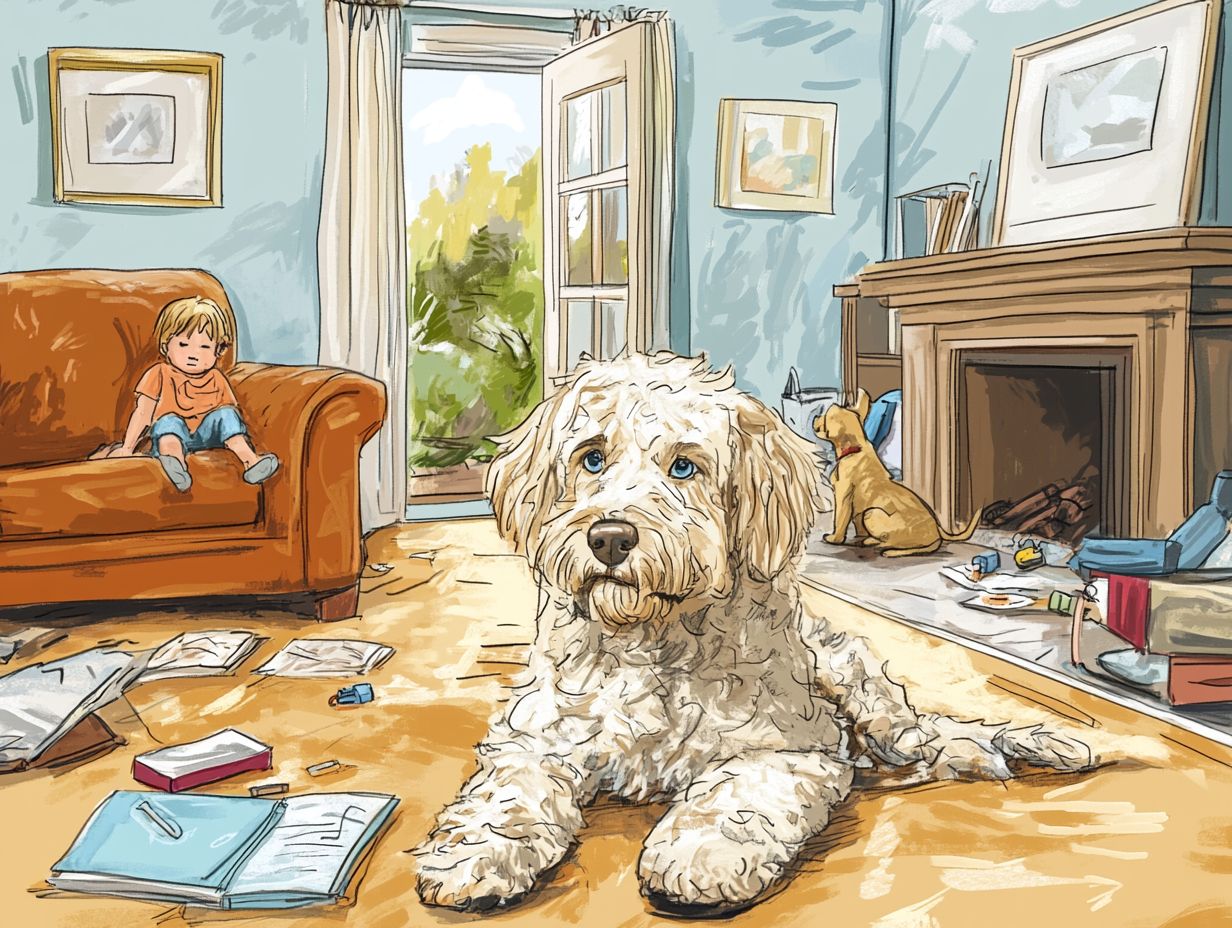
What is the influence of environment on pet anxiety?
The influence of environment on pet anxiety refers to how a pet’s surroundings and living conditions can affect their anxiety levels. This includes factors such as noise levels, socialization opportunities, and understanding the effects of age on pet anxiety and physical space.
How does noise level impact pet anxiety?
Noise level can greatly impact pet anxiety, particularly in dogs. Loud or constant noises can trigger anxiety and fear responses in pets, leading to behaviors such as excessive barking or hiding. Understanding the role of genetics in pet anxiety can also be beneficial, making it clear why providing a calm environment is crucial.
Yes, socialization opportunities can greatly impact pet anxiety. Lack of socialization can lead to fear and anxiety in pets, making them more likely to exhibit behaviors such as aggression or destructive actions. Understanding the role of outdoor play in pet anxiety can help; proper socialization helps pets feel more comfortable and confident in their environment, reducing their anxiety levels.
Start implementing these steps today to help your pet feel safe and happy!
Is physical space important for managing pet anxiety?
Physical space is crucial for managing pet anxiety. Understanding the role of space in reducing pet anxiety can help ensure pets are not confined to small or crowded areas, which may lead to increased stress.
What are some environmental factors that can contribute to pet anxiety?
Noise level, socialization opportunities, and physical space are just a few factors. Other environmental factors, such as changes in routine and exposure to unfamiliar people or animals, can also contribute to pet anxiety. Understanding temperature’s role in pet anxiety is another important aspect to consider.
How can I create a more anxiety-friendly environment for my pet?
Create a calm and safe space for your pet. Use calming pheromone diffusers and provide plenty of exercises to keep them happy and relaxed.



